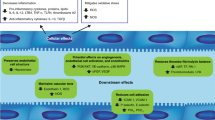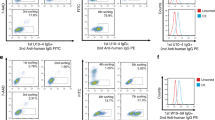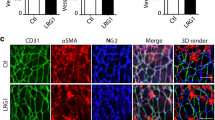Abstract
Hepatitis C virus (HCV) infection is a major problem worldwide. HCV is not limited to liver disease but is frequently complicated by immune-mediated extrahepatic manifestations such as glomerulonephritis or vasculitis. A fatal complication of HCV-associated vascular disease is thrombosis. Polyriboinosinic:polyribocytidylic acid (poly (I:C)), a synthetic analog of viral RNA, induces a Toll-like receptor 3 (TLR3)-dependent arteriolar thrombosis without significant thrombus formation in venules in vivo. These procoagulant effects are caused by increased endothelial synthesis of tissue factor and PAI-1 without platelet activation. In addition to human umbilical endothelial cells (HUVEC), human mesangial cells (HMC) produce procoagulatory factors, cytokines and adhesion molecules after stimulation with poly (I:C) or HCV-containing cryoprecipitates from a patient with a HCV infection as well. Activated protein C (APC) is able to prevent the induction of procoagulatory factors in HUVEC and HMC in vitro and blocks the effects of poly (I:C) and HCV-RNA on the expression of cytokines and adhesion molecules in HMC but not in HUVEC. In vivo, protein C inhibits poly (I:C)-induced arteriolar thrombosis. Thus, endothelial cells are de facto able to actively participate in immune-mediated vascular thrombosis caused by viral infections. Finally, we provide evidence for the ability of protein C to inhibit TLR3-mediated arteriolar thrombosis caused by HCV infection.
This is a preview of subscription content, access via your institution
Access options
Subscribe to this journal
Receive 12 digital issues and online access to articles
$119.00 per year
only $9.92 per issue
Buy this article
- Purchase on Springer Link
- Instant access to full article PDF
Prices may be subject to local taxes which are calculated during checkout





Similar content being viewed by others
References
Poynard T, Yuen MF, Ratziu V, Lai CL . Viral hepatitis C. Lancet 2003; 362: 2095–2100.
Perico N, Cattaneo D, Bikbov B, Remuzzi G . Hepatitis C infection and chronic renal diseases. Clin J Am Soc Nephrol 2009; 4: 207–220.
Agnello V, Chung RT, Kaplan LM . A role for hepatitis C virus infection in type II cryoglobulinemia. N Engl J Med 1992; 327: 1490–1495.
Ferri C, Greco F, Longombardo G, Palla P, Moretti A, Marzo E et al. Antibodies to hepatitis C virus in patients with mixed cryoglobulinemia. Arthritis Rheum 1991; 34: 1606–1610.
Cacoub P, Fabiani FL, Musset L, Perrin M, Frangeul L, Leger JM et al. Mixed cryoglobulinemia and hepatitis C virus. Am J Med 1994; 96: 124–132.
Vassilopoulos D, Calabrese LH . Hepatitis C virus infection and vasculitis: implications of antiviral and immunosuppressive therapies. Arthritis Rheum 2002; 46: 585–597.
van Gorp EC, Suharti C, ten Cate H, Dolmans WM, van der Meer JW, ten Cate JW et al. Review: infectious diseases and coagulation disorders. J Infect Dis 1999; 180: 176–186.
Akira S, Takeda K, Kaisho T . Toll-like receptors: critical proteins linking innate and acquired immunity. Nat Immunol 2001; 2: 675–680.
Alexopoulou L, Holt AC, Medzhitov R, Flavell RA . Recognition of double-stranded RNA and activation of NF-κB by toll-like receptor 3. Nature 2001; 413: 732–738.
Pircher J, Merkle M, Wörnle M, Ribeiro A, Czermak T, Stampnik Y et al. Prothrombotic effects of tumor necrosis factor alpha in vivo are amplified by the absence of TNF-alpha receptor subtype 1 and require TNF-alpha receptor subtype 2. Arthritis Res Ther 2012; 14: R225.
Mannell H, Pircher J, Chaudhry DI, Alig SK, Koch EG, Mettler R et al. ARNO regulates VEGF-dependent tissue responses by stabilizing endothelial VEGFR-2 surface expression. Cardiovasc Res 2012; 93: 111–119.
Rumbaut RE, Slaff AR, Burns AR . Microvascular thrombosis models in venules and arterioles in vivo. Microcirculation 2005; 12: 259–274.
Sohn HY, Krotz F, Gloe T, Keller M, Theisen K, Klauss V et al. Differential regulation of xanthine and NAD(P)H oxidase by hypoxia in human umbilical vein endothelial cells. Role of nitric oxide and adenosine. Cardiovasc Res 2003; 58: 638–646.
Ades EW, Candal FJ, Swerlick RA, George VG, Summers S, Bosse DC et al. HMEC-1: establishment of an immortalized human microvascular endothelial cell line. J Invest Dermatol 1992; 99: 683–690.
Mannell H, Hellwig N, Gloe T, Plank C, Sohn HY, Groesser L et al. Inhibition of the tyrosine phosphatase SHP-2 suppresses angiogenesis in vitro and in vivo. J Vasc Res 2008; 45: 153–163.
Wörnle M, Schmid H, Banas B, Merkle M, Henger A, Roeder M et al. Novel role of toll-like receptor 3 in hepatitis C-associated glomerulonephritis. Am J Pathol 2006; 168: 370–385.
Merkle M, Ribeiro A, Wörnle M . TLR3 dependent regulation of cytokines in human mesangial cells: a novel role for IP-10 and TNFa in hepatitis C associated glomerulonephritis. Am J Physiol Renal Physiol 2011; 301: 57–69.
Born G . Aggregation of blood platelets by adenosine diphosphate and its reversal. Nature 1962; 194: 927–929.
Merkle M, Ribeiro A, Köppel S, Pircher J, Mannell H, Roeder M et al. TLR3-dependent immune regulatory functions of human mesangial cells. Cell Mol Immunol 2012; 9: 334–340.
Pircher J, Czermak T, Merkle M, Mannell H, Krötz F, Ribeiro A et al. Hepatitis C virus induced endothelial inflammatory response depends on the functional expression of TNFα receptor subtype 2. PLoS One 2014; 9: e113351.
Goeijenbier M, van Wissen M, van de Weg C, Jong E, Gerdes VE, Meijers JC et al. Review: viral infections and mechanisms of thrombosis and bleeding. J Med Virol 2012; 84: 1680–1696.
Arnold R, König W . Respiratory syncytial virus infection of human lung endothelial cells enhances selectively intercellular adhesion molecule-1 expression. J Immunol 2005; 174: 7359–7367.
Gavrilovskaya IN, Gorbunova EE, Mackow ER . Pathogenic hantaviruses direct the adherence of quiescent platelets to infected endothelial cells. J Virol 2010; 84: 4832–4839.
Magro CM, Crowson AN, Dawood M, Nuovo GJ . Parvoviral infection of endothelial cells and its possible role in vasculitis and autoimmune disease. J Rheumatol 2000; 29: 1227–1235.
Mason A, Wick M, White H, Perrillo R . Hepatitis B virus replication in diverse cell types during chronic hepatitis B virus infection. Hepatology 1993; 18: 781–789.
Poland SD, Rice GP, Dekaban GA . HIV-1 infection of human brain-derived microvascular endothelial cells in vitro. J Acquir Immune Defic Syndr Hum Retrovirol 1995; 8: 437–445.
Squizzato A, Gerdes VE, Büller HR . Effects of human cytomegalovirus infection on the coagulation system. Thromb Haemost 2005; 93: 403–410.
Visseren FL, Bouwman JJ, Bouter KP, Diepersloot RJ, de Groot PH, Erkelens DW . Procoagulant activity of endothelial cells after infection with respiratory viruses. Thromb Haemost 2000; 84: 319–324.
Nicholson AC, Hajjar DP . Herpesviruses and thrombosis: activation of coagulation on the endothelium. Clin Chim Acta 1999; 286: 23–29.
Nicholson AC, Hajjar DP . Herpesvirus in atherosclerosis and thrombosis: etiologic agents or ubiquitous bystanders? Arterioscler Thromb Vasc Biol 1998; 18: 339–348.
Sutherland MR, Friedman HM, Pryzdial EL . Thrombin enhances herpes simplex virus infection of cells involving protease-activated receptor 1. J Thromb Haemost 2007; 5: 1055–1061.
Lipinski S, Bremer L, Lammers T, Thieme F, Schreiber S, Rosenstiel P . Coagulation and inflammation. Molecular insights and diagnostic implications. Hamostaseologie 2011; 31: 94–102.
Petäjä J . Inflammation and coagulation. An overview. Thromb Res 2011; 127: 34–37.
Levi M, van der Poll T, Büller HR . Bidirectional relation between inflammation and coagulation. Circulation 2004; 109: 2698–2704.
Opal SM . Interactions between coagulation and inflammation. Scand J Infect Dis 2003; 35: 545–554.
Schouten M, Wiersinga WJ, Levi M, van der Poll T . Inflammation, endothelium, and coagulation in sepsis. J Leukoc Biol 2008; 83: 536–545.
Passos AM, Treitinger A, Spada C . An overview of the mechanisms of HIV-related thrombocytopenia. Acta Haematol 2010; 124: 13–18.
Wörnle M, Roeder M, Sauter M, Merkle M, Ribeiro A . Effect of dsRNA on mesangial cell synthesis of plasminogen activator inhibitor type 1 and tissue plasminogen activator. Nephron Exp Nephrol 2009; 113: 57–65.
Kincaid-Smith P . Coagulation and renal disease. Kidney Int 1972; 2: 183–190.
Nield GH, Cameron JS . Primary glomerulonephritis. In: Remuzzi G, Rossi EC (eds). Haemostasis and the Kidney. Butterworth: London, UK. 1989 pp 56–64.
Nath KA . Tubulointerstitial changes as a major determinant in the progression of renal damage. Am J Kidney Dis 1992; 20: 1–17.
Grandaliano G, Gesualdo L, Ranieri E, Monno R, Schena FP . Tissue factor, plasminogen activator inhibitor-1, and thrombin receptor expression in human crescentic glomerulonephritis. Am J Kidney Dis 2000; 35: 726–738.
Houston G, Cuthbertson BH . Activated protein C for the treatment of severe sepsis. Clin Microbiol Infect 2009; 15: 319–324.
Abraham E, Laterre PF, Garg R, Levy H, Talwar D, Trzaskoma BL et al. Administration of drotrecogin alfa (activated) in early stage severe sepsis (ADDRESS) Study Group. N Engl J Med 2005; 353: 1332–1341.
Bernard GR, Margolis BD, Shanies HM, Ely EW, Wheeler AP, Levy H et al. Extended evaluation of recombinant human activated protein C United States Trial (ENHANCE US): a single-arm, phase 3B, multicenter study of drotrecogin alfa (activated) in severe sepsis. Chest 2004; 125: 2206–2216.
Gabre J, Chabasse C, Cao C, Mukhopadhyay S, Siefert S, Bi Y et al. Activated protein C accelerates venous thrombus resolution through heme oxygenase-1 induction. J Thromb Haemost 2014; 12: 93–102.
Martí-Carvajal AJ, SolàI I, Lathyris D, Cardona AF . Human recombinant activated protein C for severe sepsis. Cochrane Database Syst Rev 2012; 3: CD004388.
FDA Drug Safety Communication: Voluntary Market Withdrawal of Xigris [(Drotrecogin alfa (activated)] due to failure to show a survival benefit http://www.fda.gov/Drugs/DrugSafety/ucm277114.htm Accessed on 25 October 2011.
Cao C, Gao Y, Li Y, Antalis TM, Castellino FJ, Zhang L . The efficacy of activated protein C in murine endotoxemia is dependent on integrin CD11b. J Clin Invest 2010; 120: 1971–1980.
Stephenson DA, Toltl LJ, Beaudin S, Liaw PC . Modulation of monocyte function by activated protein C, a natural anticoagulant. J Immunol 2006; 177: 2115–2122.
Acknowledgements
This work was supported by grants WO 1716/1-1 from the Deutsche Forschungsgemeinschaft (DFG), a grant from the Else Kröner-Fresenius-Stiftung and the Wilhelm-Vaillant-Stiftung to MW and a grant from the Friedrich Baur Stiftung to JP.
Author information
Authors and Affiliations
Corresponding author
Ethics declarations
Competing interests
The authors declare no conflict of interest.
Rights and permissions
About this article
Cite this article
Blüm, P., Pircher, J., Merkle, M. et al. Arterial thrombosis in the context of HCV-associated vascular disease can be prevented by protein C. Cell Mol Immunol 14, 986–996 (2017). https://doi.org/10.1038/cmi.2016.10
Received:
Revised:
Accepted:
Published:
Issue Date:
DOI: https://doi.org/10.1038/cmi.2016.10
Keywords
This article is cited by
-
Double-stranded DNA induces a prothrombotic phenotype in the vascular endothelium
Scientific Reports (2017)



